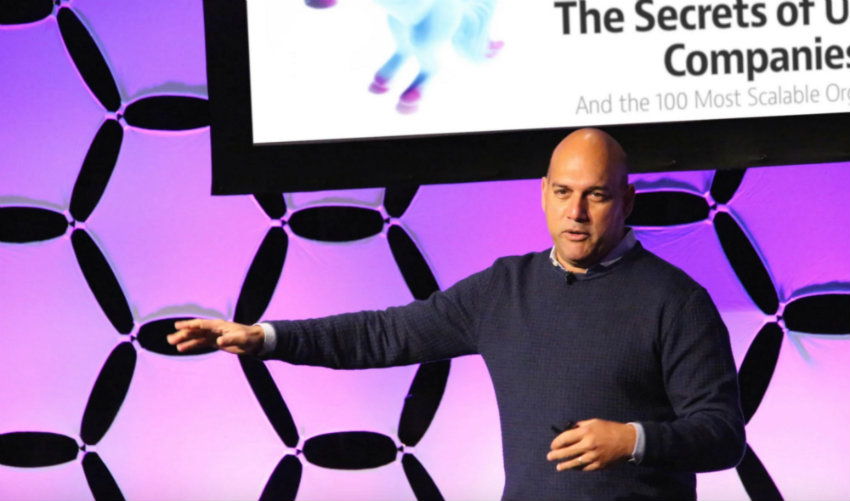Q&A with Salim Ismail, Founding Executive Director at Singularity University

How optimistic you are about the impact of technology?
I am pessimistic in the short term because we are going through this transition and most of us don’t know what we are doing. Also, our leaders have no idea how to deal with this change – all our current leadership is oriented toward managing the status quo in a linear, stable predictable world. I am optimistic, however, for the long term – 15 or 20 years from now abundance and a massive distribution of wealth will prevail thanks to new technological opportunities.
Can you give us an overview of disruptive convergence concepts?
We have about a dozen technologies doubling in price performance, annually, every 18 to 30 months. Solar energy is doubling every 22 months in price performance and drones, every nine months. We find that at intersections, there is massive disruptive capability. Technologies are converging and causing a huge disruption in pretty much every sector we see. Solar energy is the obvious one. Our estimate is that in 16 years time, solar energy will be able to provide 100 percent of the energy supply. Since it follows a doubling pattern, in 18 years it will grow 200 percent. In 20 years, 400 percent and so on.
“All of our businesses are geared toward selling scarcity. In energy, for example, we have scarce oil, coal, natural gas. With solar energy, you change the business model completely.”
Salim Ismail, Founding Executive Director at Singularity University
Organizations are now figuring out how to build business models around abundance. This is the major inflection point. Creating business models around abundance is a huge threat to business incumbents as they no longer know how to navigate.

How well are large corporations, such as the mobility companies, responding to new technologies?
They have been looking at technology as a cute opportunity on the edge, such as with driverless cars for example. However, what many of them are missing is the enormous displacing impact that can take place as a result of these technologies. We tend to see huge deflationary effects whenever there is a major information impact on an industry.
When the music business was digitizing, we saw a tenfold decrease in revenues in the industry. There was a sixfold decline in the newspaper business and one of the biggest telecom companies in the world estimated that they would see an 85 percent drop in revenues in the next five to seven years. As new technologies develop, there will be a similar decline in the car business. The fact that you can see a market shrink tenfold is pretty significant and sometimes management can do nothing about it. In reality, it’s because there is not much that they can do.
Companies have to reinvent themselves dramatically. The issue is that, in most businesses, people do not have the slightest skills nor idea how to do this.
Automakers need to face the fact that in the future no one will be driving. They should no longer optimize their products for the driver as the world is turning 180 degrees in the other direction. And every big company is facing some version of this challenge.
What current innovations do you think will have the biggest impact on society?
Bitcoin and blockchain as well as biotech and CRISPR (clustered regularly interspaced short palindromic repeats).
In the 15th century, we had a Gutenberg moment and the printing press changed everything. We’re having about 20 such Gutenberg moments today. The pace of change is just insane. Each technology is doubling on its own, but where they intersect you have a multiplier effect. When you bring four technologies to bear, like a drone that has battery technology, sensors, computing and stabilizing technology, the aggregate effect on price performance rapidly doubles.
The pace of change will soon be inconceivable. We know there is a massive transformation coming and the task now is to make sure society can absorb it.
How do you see artificial intelligence (AI) changing the world of finance?
AI has a dramatic impact on finance and I believe retail banking will disappear in about ten years. I think blockchain is perhaps the most disruptive technology I have ever seen and its real effect will be seen in government services. Blockchain confirms: “this happened at this time and on this date.” There are a huge amount of government services such as licensing and registration that serve to establish “this happened at this time and on this date.” Trademarks, copyrights, land titles, insurance claims, the cost of all these will be eliminated and it will be incredibly beneficial for society. One can actually reduce costs quite easily with technologies like blockchain.

What about the effect in medicine?
There is a massive effect in life sciences and medicine, just in terms of life expectancy alone. We think we are going to deal with cancer within the next five to seven years, Alzheimer’s in the next seven to nine years, and that we may double the human life span in the next 20 to 30 years. If I know my heart is going to give out at the age of 80, I replace it before then and I’m good to go! And so on through the other organs.
There is also CRISPR, a technology which allows you to edit the human genome. Basically, a human being is now a software engineering problem. Of course, the ethical and moral dilemmas around this technology are enormous.
We are improving and augmenting the human experience with tech, not replacing it.
What does this age of information in abundance and the Internet of Things (IoT) mean for society?
In my 2013 Personal Democracy Forum talk, “Ice, Water, Steam”, I explained how we transition through these stages in every single system in the world.
In information, for example: we used to send messages using pigeons, horses, or smoke signals. All fairly slow and localized. Then we had ships that could carry a letter around the world. Now we have e-mail, which is vaporized. So we have transitioned from ice, then water and now steam, a vaporous state for sending messages. The same applies to the monetary system: we used to trade camels and goats, then gold. Now we have bitcoins, so we have literally vaporized money. We used to have clans or tribes, which were small, local and isolated. Then we established countries and now we have multinational corporations.
As we turn the world more and more into steam, my question from a thermodynamic perspective is: How do stable structures form? The Occupy Wall Street movement, or the Arab Spring, lots of hot air but nothing stable has come of them. So, naturally we revert to the old.
“People would rather be comfortable than happy. They want to be comfortable with what they know, rather than with the unknown, which has much more potential but they don’t really understand it.”
Salim Ismail, Founding Executive Director at Singularity University
We need to make sure we bring society up to speed because every mechanism by which we run society – our politics, our civics, legal systems, healthcare, education, intellectual property, was designed a few hundred years ago.
What should both political and corporate leaders do to best transit to the world of AI, robotics, etc.?
First of all, to embrace it and jump on it, because if you don’t your competitor will. Corporations’ sole mandate has been to attract and create money, but now they have to look at how to create social value as well. As we enter the gig economy, what is the social contract between workers and the government? How does an Uber driver create a pension plan, or any stable retirement plan or financial management? Those are the questions I think our corporate leaders have to start asking and answering and if they don’t, there’s going to be a hell of a mess.
Can you give us an overview of your Global Solutions Program (GSP) at Singularity University (SU)?
Our mandate is to teach leaders and try to educate new leaders on this new world and its social responsibility. I have now been looking at how we can do this in big companies so that they adapt a little quicker.
The GSP is 10 weeks long. We bring together the world’s leading experts in technology – we had 160 speakers in the summer – and 80 students from 40 countries, with the average age of 25 – 30 years old. We receive around 5,000 applications from 120 countries for the 80 slots available.
We look for those that will be running these countries in the next 10-20 years. We bring them in, make them aware of where things are heading, and then teach them to think about impacting a billion people. By this method we believe we have a real shot at changing the future. As they achieve positions of power, the participants will act more appropriately than our current leadership. That is the Global Solutions Program.
We are part incubator, part academics, and part think tank. The real product is the leaders. The new president of Argentina is one of our alumni. The CIO in Mexico is another alumnus. We show them that they need to adapt to this new world or retire; because it’s moving too fast. Some do leave their positions, retire, and then make way for the next generation.
We’re generally moving from scarcity to abundance, and every business in the world is based on scarcity. If you don’t have scarcity, you don’t have a business. Information used to be scarce, and now it’s abundant; but it keeps being misused and misinterpreted because there’s so much of it out there![]()









